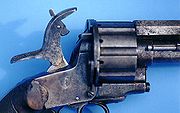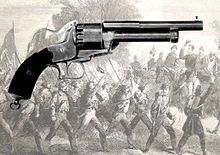
A revolver is a repeating handgun with at least one barrel and a revolving cylinder containing multiple chambers for firing. Because most revolver models hold up to six cartridges, before needing to be reloaded, revolvers are commonly called six shooters or sixguns. Due to their rotating cylinder mechanism, they may also be called wheel guns.

The pepper-box revolver or simply pepperbox is a multiple-barrel firearm, mostly in the form of a handgun, that has three or more gun barrels in a revolving mechanism. Each barrel holds a single shot, and the shooter can manually rotate the whole barrel assembly to sequentially index each barrel into alignment with the lock or hammer, similar to rotation of a revolver's cylinder.

A rim-fire is a type of metallic cartridge used in firearms where the primer is located within a hollow circumferential rim protruding from the base of its casing. When fired, the gun's firing pin will strike and crush the rim against the edge of the barrel breech, sparking the primer compound within the rim, and in turn ignite the propellant within the case. Invented in 1845 by Louis-Nicolas Flobert, the first rimfire metallic cartridge was the .22 BB Cap cartridge, which consisted of a percussion cap with a bullet attached to the top. While many other different cartridge priming methods have been tried since the early 19th century, such as teat-fire and pinfire, only small caliber rimfire cartridges have survived to the present day with regular use. The .22 Long Rifle rimfire cartridge, introduced in 1887, is by far the most common ammunition found in the world today in terms of units manufactured and sold.

The Smith & Wesson Model 29 is a six-shot, double-action revolver chambered for the .44 Magnum cartridge and manufactured by the United States company Smith & Wesson.

Ethan Allen was a major American arms maker from Massachusetts. He is unrelated to the revolutionary Ethan Allen. His first firearm, the "Pocket rifle" was developed in 1836, and his first patent was granted in 1837.
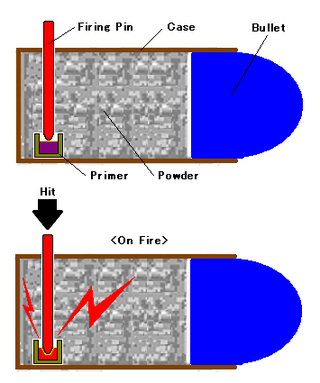
The pin-fire is an obsolete type of metallic cartridge used in firearms, where the priming compound is ignited by striking a small pin that protrudes radially from above the base of the cartridge. Invented by Frenchman Casimir Lefaucheux in 1832, but not patented until 1835, it was one of the earliest practical designs of a metallic cartridge to hasten the loading and firing process of a firearm. Its history is closely associated with the development of the breechloader, which would eventually replace all muzzle-loading firearms.

The .32 S&W Long / 7.65x23mmR, often called the .32 Long, is a straight-walled, centerfire, rimmed handgun cartridge, based on the earlier .32 S&W cartridge. It was introduced in 1896 for Smith & Wesson's first-model Hand Ejector revolver. Colt called it the .32 Colt New Police in revolvers it made chambered for the cartridge.
Robert Adams was a 19th-century British gunsmith who patented the first successful double-action revolver in 1851. His revolvers were used during the Crimean War, the Indian Mutiny, the American Civil War, and the Anglo-Zulu War.

The Smith & Wesson Model 10, previously known as the Smith & Wesson .38 Hand Ejector Model of 1899, the Smith & Wesson Military & Police or the Smith & Wesson Victory Model, is a K-frame revolver of worldwide popularity. In production since 1899, the Model 10 is a six-shot, .38 Special, double-action revolver with fixed sights. Over its long production run it has been available with barrel lengths of 2 in (51 mm), 3 in (76 mm), 4 in (100 mm), 5 in (130 mm), and 6 in (150 mm). Barrels of 2.5 inches (64 mm) are also known to have been made for special contracts. Some 6,000,000 of the type have been produced over the years, making it the most-produced handgun of the 20th century.
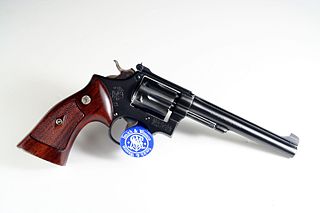
The Smith & Wesson K-22 Target Masterpiece Revolver is a six-shot, double-action revolver with adjustable open sights, built on the medium-size "K" frame. When introduced, it was intended for bullseye target shooting competition of the type then most common on the United States, which is today called NRA Precision Pistol, specifically in the "smallbore" or "22" category. It is chambered for the .22 Long Rifle cartridge. It is one of three similar models that Smith & Wesson offered, the other two being intended for the "centerfire" category, the K-32 Target Masterpiece chambered for the .32 S&W Long cartridge and the K-38 Target Masterpiece chambered for the .38 Special cartridge. Most K-22 revolvers were fitted with a 6 in (150 mm) or 8+3⁄8 in (210 mm) barrel, but other lengths have been produced. First produced in 1947 and originally known as the K-22 Target Masterpiece, it was numbered the Model 17 in 1957 when all Smith & Wesson guns were given numerical model numbers. It is built on the same frame as the seminal Smith & Wesson Model 10 revolver.
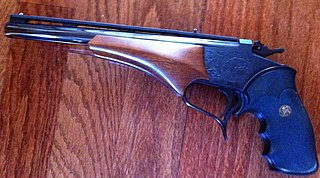
The Thompson/Center Contender is a break-action single-shot pistol or rifle that was introduced in 1967 by Thompson/Center Arms. It can be chambered in cartridges from .17 Bumble Bee to .45-70 Government.
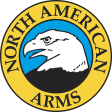
North American Arms is a United States company, headquartered in Provo, Utah, that manufactures pocket pistols and mini-revolvers, also called mouse guns. The company was originally named Rocky Mountain Arms when it was founded in 1972. In 1974 it was bought by new owners who renamed the company North American Manufacturing (NAM) and then North American Arms (NAA).

An antique firearm is a term used to describe a firearm that was designed and manufactured prior to the beginning of the 20th century. Although the exact definition of what constitutes an "antique firearm" varies between countries, the advent of smokeless powder or the start of the Boer War are often used as cut-off dates. Antique firearms are usually collected because of their historical interest and/or their monetary value.

A handgun is a firearm designed to be usable with only one hand. It is distinguished from a long barreled gun which typically is intended to be held by both hands and braced against the shoulder. Handguns have shorter effective ranges compared to long guns, and are much harder to shoot accurately. While most early handguns are single-shot pistols, the two most common types of handguns used in modern times are revolvers and semi-automatic pistols.

The Colt New Model revolving rifles were early repeating rifles produced by the Colt's Manufacturing Company from 1855 until 1864. The design was essentially similar to revolver type pistols, with a rotating cylinder that held five or six rounds in a variety of calibers from .36 to .64 inches. They were mainly based upon the Colt Model 1855 Sidehammer Pocket Revolver developed by Elisha K. Root. Colt revolving pistols and rifles were attractive mainly because of their high rate of fire. They were used to a limited extent on the Pony Express and made a brief appearance in the American Civil War. However, the rifles were generally disliked by soldiers, and were ultimately discontinued due to serious design flaws.

In firearms, the cylinder is the cylindrical, rotating part of a revolver containing multiple chambers, each of which is capable of holding a single cartridge. The cylinder rotates (revolves) around a central axis in the revolver's action to sequentially align each individual chamber with the barrel bore for repeated firing. Each time the gun is cocked, the cylinder indexes by one chamber. Serving the same function as a rotary magazine, the cylinder stores ammunitions within the revolver and allows it to fire multiple times, before needing to be reloaded.
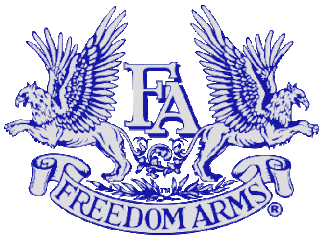
Freedom Arms is a Freedom, Wyoming–based firearm manufacturing company, known for producing powerful single-action revolvers. The company was founded in 1978 by Wayne Baker and Dick Casull to produce a mini-revolver, then later a revolver chambered in Casull's powerful .454 Casull revolver cartridge. This five-shot revolver was the Model 83. Freedom Arms currently makes a single-shot pistol in addition to their revolvers.
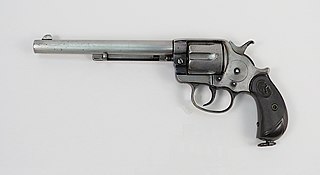
The Colt M1878 is a double-action revolver that was manufactured by Colt's Manufacturing Company from 1878 until 1907. It is often referred to as the "Frontier" or the "Double Action Army" revolver, and was manufactured to shoot a variety of rimmed, centerfire, and black powder cartridges, in calibers detailed nearby. A total of 51,210 Model 1878 revolvers were manufactured, including 4,600 for the US Ordnance Department. These are known as the "Philippine" or "Alaskan" models.

The Protector Palm Pistol is a small revolver designed to be concealed in the palm of the hand. It was unique in that the revolver was clasped in a fist with the barrel protruding between two fingers and the entire handgun was squeezed in order to fire a round. The design was meant to resemble a pocket watch to the extent of being carried on a chain.

The Colt House Revolver was one of the first metallic cartridge rear-loading revolvers to be produced by the Colt's Patent Fire Arms Manufacturing Company, in 1871. The same year, Colt's also patented the Colt Open Top, another metallic cartridge rear-loader, but in fact the Open Top production didn't start until 1872, although a pocket version of the Open Top, a completely different design, went on sales as of 1871, the Colt Open Top Pocket Model Revolver.



